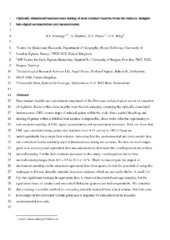Optically stimulated luminescence dating of heat retainer hearths from the Sahara: Insights into signal accumulation and measurement
Peer reviewed, Journal article
Accepted version
Permanent lenke
https://hdl.handle.net/1956/22263Utgivelsesdato
2019Metadata
Vis full innførselOriginalversjon
https://doi.org/10.1016/j.quageo.2018.03.004Sammendrag
Heat retainer hearths are a prominent component of the Holocene archaeological record of a number of drylands. Rocks within these hearths were fired in antiquity, emptying the optically stimulated luminescence (OSL) source traps of mineral grains within the rock. Since partial bleaching and mixing of grains within a lithified heat retainer is impossible, these rocks offer the opportunity to test our understanding of OSL signal accumulation and measurement processes. First, we show that OSL ages calculated using grains size fractions from 4 to 11 μm up to 180–210 μm are indistinguishable for a single heat retainer, indicating that the environmental and instrumental dose rate correction factors routinely used in luminescence dating are accurate. Second, we used single-grain dose recovery and equivalent dose measurements to determine the overdispersion due to beta microdosimetry. For the heat retainers measured in this study, overdiseprsion due to beta microdosimetry ranges from 8.9 ± 1.8 to 20.3 ± 1.6%. Third, we investigate the impact of mechanical crushing on the measured equivalent dose from quartz, to test the potential of using this technique to liberate dateable material from heat retainers which are not acid soluble. A small (<1 Gy) but significant increase in equivalent dose is observed in crushed zero-age samples, but the equivalent doses of crushed and uncrushed Holocene quartzes are indistinguishable. We conclude that crushing is a viable method for extracting dateable material from a heat retainer, but that some knowledge of the dosimeter's mean grain size is required for calculation of an accurate environmental dose rate.

